Specimens of ''Tyrannosaurus''

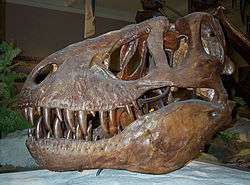
Tyrannosaurus rex, one of the most iconic dinosaurs, is known from numerous specimens, some of which have acquired a degree of notability in their own right because of their scientific importance and coverage by the media. See Tyrannosaurus for more information on the genus itself.
Specimen data
Early discoveries

The holotype of Tyrannosaurus rex, a partial skull and skeleton originally called AMNH 973 (AMNH stands for American Museum of Natural History), was discovered in the U.S. state of Montana in 1902 and excavated over the next three years. Another specimen (AMNH 5866), found in Wyoming in 1900, was described in the same paper under the name Dynamosaurus imperiosus. At the time of their initial description and naming, these specimens had not been fully prepared and the type specimen of T. rex had not even been fully recovered.[1] In 1906, after further preparation and examination, Henry Fairfield Osborn recognized both skeletons as belonging to the same species. Because the name Tyrannosaurus rex had appeared just one page earlier than Dynamosaurus in Osborn's 1905 work, it was considered the older name and has been used since. Had it not been for page order, Dynamosaurus would have become the official name.[2]
Manospondylus: AMNH 3982
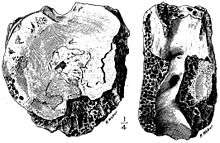
The first named fossil specimen which can be attributed to Tyrannosaurus rex consists of two partial vertebrae (one of which has been lost) found by Edward Drinker Cope in 1892. Cope believed that they belonged to an "agathaumid" (ceratopsid) dinosaur, and named them Manospondylus gigas, meaning "giant porous vertebra" in reference to the numerous openings for blood vessels he found in the bone.[3] The M. gigas remains were later identified as those of a theropod rather than a ceratopsid, and H.F. Osborn recognized the similarity between M. gigas and Tyrannosaurus rex as early as 1917. However, due to the fragmentary nature of the Manospondylus vertebrae, Osborn did not synonymize the two genera.[4]
Holotype: CM 9380
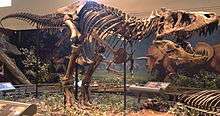
CM 9380 is the type specimen used to describe Tyrannosaurus rex. Fragments of (then) AMNH 973 were first found in 1902 by Barnum Brown, assistant curator of the American Museum of Natural History and a famous paleontologist in his own right. He forwarded news of it to Osborn; it would be three years before they found the rest of it. It has been reconstructed in recent years, it measured an estimated 11.9 meters in length and an estimated weight of 7.4–14.6 metric tonnes, 9.1 metric tonnes being the average estimate in that study, although most earlier studies have suggested lower weight figures.[5] In 1905 when the type was described by Osborn, previous knowledge of dinosaur predators at the time were based on Jurassic carnosaurs, so the short fore-arms of the Tyrannosaurus were treated with extreme caution, with suspicion that bones of a smaller theropod had become jumbled with the remains of the bigger fossil.[1][6] Following the 1941 entry of the United States into World War II, the holotype was sold to the Carnegie Museum of Natural History in Pittsburgh for protection against possible bombing raids.[7] The specimen, now labeled CM 9380, is still mounted in Pittsburgh, at first with the tail acting as a tripod in the old fashioned kangaroo pose. It has since received a modernization of its posture and can now be found balancing with tail outstretched.
AMNH 5027
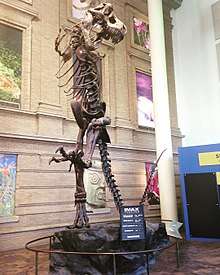
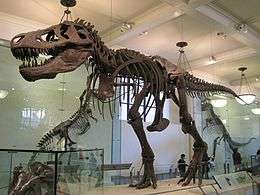
AMNH 5027 was discovered and excavated in 1908 by Barnum Brown in Montana, and described by Osborn in 1912 and 1916. At the time of discovery, a complete cervical (neck vertebrae) series for Tyrannosaurus was not previously known, so it was this specimen that brought the short, stocky tyrannosaur neck to light. Compared to later specimens (BMNH R7994 and FMNH PR2081, for instance) the cervical series of AMNH 5027 is much more gracile, so with later discoveries the distinction between tyrannosaurid necks and the necks of carnosaurs became more obvious.[8] This specimen also provided the first complete skull of Tyrannosaurus rex. In total, Brown found five partial Tyrannosaurus skeletons.
Famous mount
Osborn planned to mount the similarly-sized AMNH 5027 and AMNH 973 together in dynamic poses.[9] Designed by E.S. Christman, the scene was to depict a rearing Tyrannosaurus (AMNH 5027) snapping at another cowering one (AMNH 973), as they fought over the remains of a hadrosaur, described at the time as Trachodon:

It is early morning along the shore of a Cretaceous lake four million years ago.[nb 1] A herbivorous dinosaur Trachodon venturing from the water for a breakfast of succulent vegetation has been caught and partly devoured by a giant flesh eating Tyrannosaurus. As this monster crouches over the carcass, busy dismembering it, another Tyrannosaurus is attracted to the scene. Approaching, it rises nearly to its full height to grapple the more fortunate hunter and dispute the prey. The crouching figure reluctantly stops eating and accepts the challenge, partly rising to spring on its adversary. The psychological moment of tense inertia before the combat was chosen to best show positions of the limbs and bodies, as well as to picture an incident in the life history of these giant reptiles.[6]
However, technical difficulties prevented the mount from being executed. One obvious problem was that the Cretaceous Dinosaur Hall was too small to accommodate this dramatic display, and AMNH 5027 was already mounted by itself as the central attraction of the hall. The fore-arms of Tyrannosaurus were not well documented and the hands were unknown, so for the sake of the display, the forearms of AMNH 5027 were given three fingers, based on the forelimbs of Allosaurus (the more allosaur-like arms were replaced several years later when better fossils of tyrannosaurid arms were found).
The mount retained a rearing pose similar to the initial proposal. By the 1980s it was generally accepted that such a pose would have been anatomically impossible in life, and the skeleton was re-mounted in a more accurate, horizontal pose during a renovation of the museum's dinosaur halls in the early 1990s. The mount can still be seen on display on the fourth floor of the American Museum.
In 1960, after the Second World War, the holotype of Dynamosaurus imperiosus (AMNH 5866) and a second specimen (AMNH 5881) were also sold and now reside in the collections of the Natural History Museum, London (formerly the British Museum of Natural History), where they are known as BMNH R7994 and BMNH R7995, respectively.[10] The American Museum of Natural History features AMNH 5027 in its famed Hall of Saurischian Dinosaurs to this day.
1940s–1990s

Very few other Tyrannosaurus rex skeletons were discovered until the late 1980s. The skull of Nanotyrannus, frequently considered to be a juvenile T. rex, was recovered from Montana in 1942. In 1966, a crew working for the Natural History Museum of Los Angeles County under the direction of Harley Garbani discovered another T. rex (LACM 23844) which included most of the skull of a very large, mature animal. When it was put on display in Los Angeles, LACM 23844 was the largest T. rex skull on exhibit anywhere. Garbani also discovered several other partial skeletons over the next decade (including LACM 23845, the holotype of "Albertosaurus" megagracilis), some of which are maintained in the collections of the University of California Museum of Paleontology in Berkeley, California. Other skulls and partial skeletons were discovered in South Dakota and Alberta, Canada in the early 1980s.[11]
Before 1987, Tyrannosaurus rex was thought to be rare.[11] However, the last two decades have seen the discovery and description of over a dozen additional specimens. The first, nicknamed "Stan" in honor of its discoverer, amateur paleontologist Stan Sacrison, was found in the Hell Creek Formation near Buffalo, South Dakota, in the spring of 1987. After 30,000 hours of digging and preparation by the Black Hills Institute, beginning in 1992, 65% of a skeleton emerged, including a complete skull. Stan (BHI 3033) is currently on display in the Black Hills Museum of Natural History in Hill City, South Dakota following an extensive world tour, and replicas sold by the Black Hills Institute are also found in museum exhibit halls around the world. This specimen exhibits many bone pathologies, including broken and healed ribs, a broken and healed neck and a spectacular hole in the back of its head, about the size of a Tyrannosaurus tooth.[12]
"Black Beauty": RTMP 81.6.1
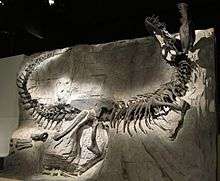
Black Beauty (specimen number RTMP 81.6.1) is a well preserved fossil of Tyrannosaurus rex. The nickname stems from the apparent shiny dark color of the fossil bones, which occurred during fossilisation by the presence of minerals in the surrounding rock. The specimen is housed in the Royal Tyrrell Museum in Drumheller, Alberta, Canada.[13] Black Beauty is the 14th most complete known skeleton of Tyrannosaurus rex, featuring 85 original bones (28% complete).[14][15] Casts are on display in museums around the world, like the display at Naturhistoriska Riksmuseet in Stockholm, Sweden. In 2009, a paper by Jack Horner and colleagues illustrated the concept of parasitic infections in dinosaurs by analysing the lesions found on the cranial bones of Black Beauty.[16] The specimen has been used to study comparative morphology between tyrannosaurids and Tyrannosaurus individuals, and some have suggested that Black Beauty should be classed as Dynamosaurus (=Tyrannosaurus).[17] It has been claimed to be the smallest adult T. rex specimen known,[18] even though a number of other adults[19][20] have skeletal measurements that are similar to or smaller than those of Black Beauty.[21]
Black Beauty was found in 1980 by Jeff Baker, while on a fishing trip with a friend in the region of the Crowsnest Pass, Alberta. A large bone was found in the riverbank and shown to their teacher. Soon afterward, the Royal Tyrrell Museum was contacted,[22] and excavation of the sandstone matrix surrounding the fossils began in 1982.[23]
Replicas of Black Beauty have been shown in some exhibitions and museums, including both simple skull montages and complete skeletons. The Naturhistoriska riksmuseet in Stockholm has a mounted complete skeleton of Black Beauty as one of their primary exhibitions called 4 ½ miljarder år, featuring the history of earth and life.[24] Black Beauty has also been displayed in Paleozoological Museum,[25] and a replica of the skull is on display at the Museum of African Culture.[26] It was also part of the traveling exhibit Dinosaur World Tour in the 1990s[27]
"Wankel Rex": MOR 555
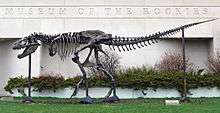
In 1988, local rancher Kathy Wankel discovered another Tyrannosaurus rex in Hell Creek sediments on an island in the Charles M. Russell National Wildlife Refuge of Montana. This specimen was excavated by a team from the Museum of the Rockies led by paleontologist Jack Horner, with assistance from the U.S. Army Corps of Engineers. The specimen, given the number MOR 555 but informally called the "Wankel rex," includes approximately 46 percent of the skeleton, including the skull, as well as what at the time was the first complete T. rex forelimb. It has a recently estimated length of around 11.6 meters (38 ft) and a weight between 5.8 metric tons (6.4 short tons) and 10.8 metric tons (11.9 short tons) in newer figures, 8.3 metric tons (9.1 short tons) being the average estimate.[28] It was long on exhibit at the Museum of the Rockies in Bozeman, Montana.[11] Casts of MOR 555 are on display at the National Museum of Scotland,[29] the Australian Fossil and Mineral Museum, and the University of California Museum of Paleontology. A bronze cast of the specimen, known as "Big Mike", stands outside the Museum of the Rockies.[30]
It is estimated that the "Wankel rex" was 18 years old when it died, an adult but not completely grown. The "Wankel rex" was also one of the first fossil dinosaur skeletons studied to see if biological molecules still existed within the fossilized bones. Doctoral candidate Mary Schweitzer found heme, a biological form of iron that makes up hemoglobin (the red pigment in blood).[30]
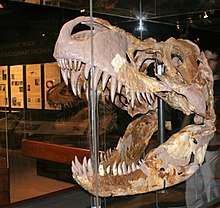
The Corps of Engineers owns the "Wankel rex", and for years permitted its display at the Museum of the Rockies. In June 2013, the Corps loaned the specimen to the National Museum of Natural History, Smithsonian Institution museum in Washington, D.C., for 50 years. The specimen went on temporary display on National Fossil Day, 16 October 2013, and was exhibited until the museum's dinosaur hall exhibit closed for renovation in the spring of 2014. The skeleton will be the centerpiece of the dinosaur hall when it reopens in 2019.[31] (The Museum of the Rockies has about a dozen T. rex skeletons, and will mount an 80 percent-complete specimen once the "Wankel rex" has been shipped to the Smithsonian.)[30]
Museum of the Rockies also houses a large Tyrannosaurus rex skull catalogued as MOR 008. The skull bones were found and collected in 1960´s near Billings, Montana and the reconstructed skull was put on display in 2006. The skull is about 1.4 meters long.
"Sue": FMNH PR2081
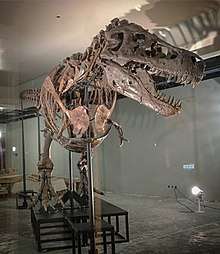
Susan Hendrickson of the Black Hills Institute discovered the best-preserved Tyrannosaurus currently known, in the Hell Creek Formation near Faith, South Dakota, on 12 August 1990. This specimen, named "Sue" in honor of its discoverer, soon became embroiled in a legal battle over its ownership. The land on which the fossil was discovered was found to lie within the Cheyenne River Indian Reservation and is occupied by the family of Maurice Williams, a Native American of the Sioux tribe. In 1992, Williams claimed he still owned the fossil, for which the Black Hills Institute had paid him USD 5,000. The local Cheyenne River Sioux Tribe, of which Williams is a member, also claimed ownership. The fossil, as well as many thousands of pages of field notes and business records, were confiscated by the Federal Bureau of Investigation in 1992 and held throughout the ensuing court proceedings. In 1997, the suit was settled in favor of Maurice Williams because his land is technically held in trust for him by the United States government. Therefore, although the Black Hills Institute had paid Williams for the fossil, it was judged that the fossil could be considered "land" which Williams owned but could not legally sell without government permission. The fossil was returned to Williams' ownership and Pete Larson, vice-president of the Black Hills Institute, was sentenced to two years in federal prison for an unrelated customs violation discovered by the FBI while searching through his business records. Williams quickly offered up "Sue" for auction by Sotheby's in New York, where it was sold to the Field Museum of Natural History in Chicago for USD 8.4 million – the highest price ever paid for a fossil.
Preparation of "Sue" (FMNH PR2081) was completed at the Field Museum and her skeleton was placed on exhibit on 17 May 2000.[32][33] A replica of Sue is on exhibit at Disney's Animal Kingdom in Walt Disney World[34]
About 90% of the skeleton was recovered,[35] allowing the first complete description of a Tyrannosaurus rex skeleton.[36]
It has a length of 12.3 meters (40 ft), stands 3.66 m (12 ft) tall at the hips, and according to the most recent studies estimated to have weighed between 8.4 to 14 metric tons when alive.[28][37][38] In one of these studies, estimations by Hutchinson et al. (2011) point out to a figure of 14 metric tonnes being the average estimate. Authors have stated that their upper [18.5 metric tonnes] and lower [9.5 metric tonnes] estimates were based on models with wide error bars and that they "consider [them] to be too skinny, too fat, or too disproportionate".[28] Historically older estimations have produced figures as low as 5.7–6.4 metric tonnes for this specimen.[39][40]
Sue's impressive size may have been archived due to a prolonged ontogenic development, since it is the oldest Tyrannosaurus known by a big margin. Her age at the time of death was estimated by Peter Mackovicky and the university of Florida to be 28 years old, over 6–10 years older than most big Tyrannosaurus specimens, like MOR 555, AMNH 5027 or BHI 3033.[41] (Sue's age study description at page 9 of the Sue's educator official guide from Field museum of Natural history)[42]
"Stan": BHI 3033
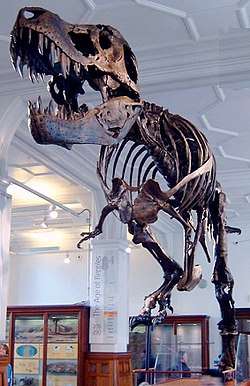
Stan is the nickname given to a fossil found in Hell Creek Formation, South Dakota, close to Buffalo in 1987 by Stan Sacrison, who also discovered the Tyrannosaurus specimen nicknamed "Duffy". The original fossils are now housed at Black Hills Institute of Geological Research, Inc. center. It is a well known specimen, and one of the most complete,[43] with 199 bones recovered.[44] About 30 casts of the original fossil have been sold worldwide, each for a price of about $100,000.[45][46] Stan's mount measures 11.8 meters long, while Scott Hartman's restoration yields an 11.3 meter long estimate. He attributes the difference to the awkward spacing the mounted skeleton shows between its cervical vertebrae and its cranium.[47] There is an extended misconception that Stan is 10.9 meters long, but that was just an (admitted) typo committed by Hartman in one of his works.[48] According to new studies Stan's weight has been estimated between 5.9 metric tons (6.5 short tons) and 10.8 metric tons (11.9 short tons), 8.4 metric tons (9.3 short tons) being the average estimate.[28]

Casts of Stan's skeleton can be found in many displays around the world. A cast can be found at Manchester Museum, and it has also been at The Children's Museum of Indianapolis together with the Tyrannosaurus specimen "Bucky" and the Triceratops "Kelsey",[49] as well as New Mexico Museum of Natural History and Science[50] and Houston Museum of Natural Science. Other casts are located at the National Museum of Natural History, the Rocky Mountain Dinosaur Resource Center, the Oxford University Museum of Natural History, the Natural History Museum in Oslo, the Cerritos Public Library in Cerritos, California, at the Googleplex,[51] the Wyoming Dinosaur Center, and at Dinópolis (Teruel, Spain).
When BBC tested the power of Tyrannosaurus jaws in their program The Truth About Killer Dinosaurs (2005), the hydraulic skull model was based on Stan's skull which measures 1.40 meters long[52] and is the best preserved T rex skull. Gregory Erickson estimated the bite power, and came to the conclusion that Tyrannosaurus would have had a bite force of about 6.8 tonnes, or 60,000 Newtons. Stan has also been used for studies involving restoration of dinosaurs body mass and study on how they could have moved.[53][54]
Like many other fossils of Tyrannosaurus rex, the skeleton of Stan shows many broken and healed bones. These include broken ribs and damages in the skull. One of the most prominent injuries are in the neck and the skull. A piece of bone is missing at the rear, and the skull also bears a hole 1 inch wide, probably made by another Tyrannosaurus. Also, two of the cervical vertebrae are fused, and another has additional bone growth. This could have been caused by another Tyrannosaurus bite. The bite marks are healed, indicating that Stan survived the wounds.[55] Stan could also have been infected by Trichomonas-like parasites.[56]
"Peck's Rex": MOR980
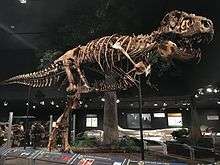
Peck's Rex (also known as "Peckrex", "Rigby's rex" and Tyrannosaurus "imperator") is the nickname given to a fossil specimen found in Montana in 1997.[57] The discovery was made by Louis E. Tremblay on 4 July 1997 working under the supervision of J. Keith Rigby Jr. who led the excavation and bone preparation.
The fossil got its nickname after Fort Peck, which is located close to the place of discovery. Peck's Rex has been part of several exhibitions on dinosaurs, and is specifically famous because it was the first specimen of its species to have Metacarpal III preserved.[58][59]
The fossil of Peck's Rex is relatively well preserved.[60] The skeleton includes a relatively complete skull with jaws, multiple vertebrae of the back and tail, a well preserved gastralium, and hipbone with complete ischium and pubis. The left hindleg is relatively complete with a 1,29 meters long femur, missing only some toe bones. The forelimbs include the scapula and furcula, both humeri and right hand phalanges, as well as metacarpal III. Because the skeleton is of the gracile morphotype, Peck's Rex is believed to be a male, although the hypothesis which suggests that the sex of Tyrannosaurus specimens can be determined by the degree of skeletal sturdiness has been debated in recent years. Peck's Rex has been the subject of research regarding parasitic infections in dinosaurs.[61] The forelimbs of Peck's Rex have also been studied as they show evidence of use. This evidence includes the construction of metacarpal III, as well as repeated fractures in the furcula – possibly caused by heavy loads or pressure (Carpenter and Lipkin, 2005).[62]
Casts of Peck's Rex have been featured at several museums including the Maryland Science Center, the Fort Peck Interpretive Center and Museum[63] (beside a lifesized model), and the Carnegie Museum of Natural History as part of the exhibit: Dinosaurs in Their Time where it is mounted in a "face off" position against the holotype Tyrannosaurus skeleton (CM 9380).[64][65][66][67] Cast pieces and skeletons of Peck's rex (like forelimbs, teeth, and parts of the jaws and feet) are also for sale.[68] Peck's Rex real fossilized bones are exhibited at The Museum of the Rockies as part of a full body mount completed with plaster replacing the missing bones, and was nicknamed Montana's Rex. This was made since their old main T rex's complete real skeleton; Wankel Rex (now nicknamed Nation's Rex) was sent to Washington DC Smithsonian's museum to occupy a central part in the museum's dinosaur hall, featuring a dynamic mount showing the apex predator devouring a triceratops carcass.[69]
"Bucky": TCM 2001.90.1
%2C_Kelsey_(Triceratops_fossil)_and_Stan_(T._rex_cast).jpg)
Bucky is a fossil of a juvenile specimen located in The College of Charleston's Addlestone Library in Charleston, South Carolina, United States. Some paleontologists suggest that female T. rex were of the robust morphotype, which includes Bucky, but this method for distinguishing gender is not universally accepted.[70] It is the first juvenile Tyrannosaurus ever placed on permanent exhibit in a museum and was the first to be identified with a furcula.[71]
Bucky has a bird-like skeletal structure, as it is one of the few dinosaur fossils found with a furcula.[72] A furcula, or fused clavicles, is a boomerang shaped "wishbone" that would measure 29 centimetres (11 in) wide and 14 centimetres (5.5 in) high. Bucky's furcula is the first one found for the genus Tyrannosaurus.[73] The furcula is thought to be a link between dinosaurs and birds and is the center of debate surrounding the origin of birds. Bucky also has a nearly complete set of gastralia, or belly ribs, and an ulna, or lower arm bone. As of now, 101 bones, or about 34% of Bucky's skeleton, has been discovered and verified.[74] Bucky is the sixth most complete Tyrannosaurus rex out of more than 40 that have been discovered.[71] Bucky's tail is the third most complete tail of any Tyrannosaurus rex known and has a nearly complete vertebral column to the end of the pelvis. Bucky's skull is a reconstruction which utilized modified casts of other Tyrannosaurus rex specimens.[75]
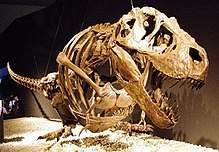
Bucky is displayed in the Children's Museum of Indianapolis. Found in Dinosphere, Bucky is displayed along with Stan, an adult Tyrannosaurus, in a hunting scene. Both dinosaurs are attacking Kelsey the Triceratops. Bucky attacks Kelsey from behind, while Stan acts as a diversion in front of the triceratops. The end of the fight is left ambiguous. Bucky is displayed with a full set of gastralia, which is unusual. But because Bucky was discovered with a full set, it is displayed along with it.[76]
The dinosaur remains were found in 1998 in the Hell Creek Formation near the town of Faith, South Dakota. The skeleton, transported by water, ended up in a low shallow valley along with bones from an Edmontosaurus and Triceratops. It was discovered by rancher and cowboy Bucky Derflinger. The excavation site was 150 by 30 feet (45.7 m × 9.1 m), about 4,500 square feet (420 m2).[74] Bucky was well preserved and easily prepared by the Black Hills Institute in South Dakota. Excavation and preparation of Bucky was relatively easy because the surrounding rock matrix was soft.[77]
Bucky Derflinger found Bucky's skeleton in 1998 when he was 20 years old. He was a rancher and a rodeo cowboy. While breaking in a young horse on his father's ranch, Derflinger discovered a pes phalange, or toe bone, from Bucky's skeleton. He has also discovered another Tyrannosaurus and a slew of remains of duck-billed dinosaurs on his father's land. Derflinger is the youngest person to discover a Tyrannosaurus. He has been collecting dinosaur fossils since he was eight years old.[78]
"Jane": BMRP 2002.4.1
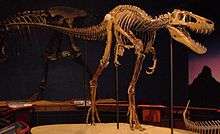
Jane is a fossil specimen of small tyrannosaurid dinosaur (Nanotyrannus lancensis or a juvenile Tyrannosaurus), officially known as BMRP 2002.4.1, discovered in the Hell Creek Formation in southern Montana in 2001.[79]
After four years of preparation, Jane was put on display at Rockford, Illinois' Burpee Museum of Natural History as the centerpiece of an exhibit called "Jane: Diary of a Dinosaur." Paleontologists who support the theory that Jane represents a juvenile believe the tyrannosaur was approximately 11 years old at its time of death, and its fully restored skeleton measured 6.5 metres (21.3 ft) long, a bit more than half as long as the largest known complete T. rex specimen, nicknamed "Sue," which measures 12.3 m (40.4 ft) long. According to Hutchinson et al. (2011), the weight of the Jane specimen in life was probably between 639 kg (1,409 lb) and 1,269 kg (2,798 lb), 954 kg (2,103 lb) being the average estimate.[28] Its large feet and long legs indicate it was built for speed and could possibly run as fast as 20–30 miles per hour. Its lower jaw has 17 curved, serrated teeth.
Despite having a typically female name, Jane's sex is unknown—the specimen was named after Burpee Museum benefactor Jane Solem. The specimen was found in the summer of 2001 by Carol Tuck and Bill Harrison on an expedition led by Burpee Museum curator Michael Henderson.[80]
The Jane specimen has been central to the debate regarding the validity of the proposed tyrannosaurid genus Nanotyrannus. Jane's skull is nearly identical to the skull of the original Nanotyrannus specimen, confirming that they belong to the same species. A conference was held at the Burpee museum in 2005, during which paleontologists debated whether these "pygmy tyrants" represented adult specimens of a small species, or juvenile specimens of Tyrannosaurus rex. While there were a few dissenters,[81] a majority of paleontologists at the conference decided on the latter, and that both Jane and Nanotyrannus were juvenile T. rex.[82][83] However, the Jane material has yet to be properly studied and described by scientists. Although Larson (2013) saw Jane as more identical to CMNH 7541 and LACM 28471 than to adult T. rex in having a higher tooth count, large pneumatic foramen on the center of the quadratojugal, T-shaped postorbital, and fused shoulder blade and pelvis,[84] Yun (2015) concurred with the opinion of most workers that Nanotyrannus is a juvenile T. rex, noting that a juvenile specimen of Tarbosaurus described by Tsuihiji et al. (2011) also has a T-shaped postorbital.[85]
"B-rex": MOR 1125
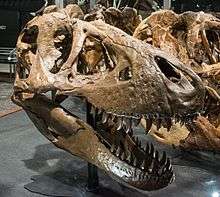
This specimen was found in the lower portion of the Hell Creek Formation near Fort Peck Lake in the Charles M. Russell National Wildlife Refuge in Garfield County, Montana. Its discoverer was Bob Harmon, a fossil preparer for the Museum of the Rockies, and was nicknamed the "B-rex" (or "Bob-rex") in honor of Harmon. The specimen was discovered in 2000, and excavated by MOR from 2001 to 2003.[86] Although only 37 percent of the skeleton was present, this included almost all of the skull (although the skull was nearly completely disarticulated). The specimen also includes several cervical, dorsal, sacral, and caudal vertebrae; several chevrons; some cervical and dorsal ribs; left scapula and coracoid; the furcula; the left ulna; both femora, tibiae, and ulnae; the right calcaneum; right astragalus; and a number of pes phalanges.[87]

In the March 2005 Science magazine, Mary Higby Schweitzer of North Carolina State University and colleagues announced the recovery of soft tissue from the marrow cavity of a fossilized leg bone (a 1.15 m long femur), from a 68-million-year-old Tyrannosaurus. The bone had been intentionally, though reluctantly, broken for shipping and then not preserved in the normal manner, specifically because Schweitzer was hoping to test it for soft tissue. Designated MOR 1125 (and known informally as B-rex), the dinosaur had been excavated from the Hell Creek Formation. Flexible, bifurcating blood vessels and fibrous but elastic bone matrix tissue were recognized. In addition, microstructures resembling blood cells were found inside the matrix and vessels. The structures bear resemblance to ostrich blood cells and vessels. However, since an unknown process distinct from normal fossilization seems to have preserved the material, the researchers are being careful not to claim that it is original material from the dinosaur.[88] If it is found to be original material, any surviving proteins may be used as a means of indirectly guessing some of the DNA content of the dinosaurs involved, because each protein is typically created by a specific gene. The absence of previous finds may merely be the result of assumptions that soft tissue could not be preserved, so that nobody had looked for it. Since the first, two more tyrannosaurs and a hadrosaur have also been found to have such tissue-like structures.[89][90]
Paleontologist Thomas Kaye of the University of Washington in Seattle has also hypothesized that the soft-tissue is permineralized biofilm created by bacteria while digesting and breaking down the original specimen. He has discovered this to be true in many specimens from the same area.[91]
In 2016, it was finally confirmed by Mary Higby Schweitzer and Lindsay Zanno et al that the soft tissue was medullary bone tissue, like that in modern birds when they are readying to lay eggs. This also confirmed the identity of the Tyrannosaurus MOR 1125 as a female. The discovery of medullary bone tissue within Tyrannosaurus may prove valuable in determining the sex of other dinosaur species in future examinations.[92]
"Samson"
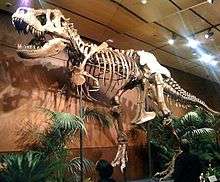
Following the sale of "Sue," another Tyrannosaurus rex skeleton was, under the individual name of "Z-rex", put up for auction on eBay in 2000 with an asking price of over USD 8 million. It failed to sell online but was purchased for an undisclosed price in 2001 by British millionaire Graham Ferguson Lacey, who renamed the skeleton "Samson" after the Biblical figure of the same name.
This specimen, discovered on private land in Harding County, South Dakota in 1981 by Michael Zimmerschied, and Dee Zimmerschied and on 4 October 1992 (Alan and Robert Detrich re-discovered Samson after it was originally found and deemed by paleontologists that several bones had washed in and there was nothing left). It was shortly after that when the Detrich brothers found the most complete and undistorted Tyrannosaurus rex skull ever discovered, which was prepared by the Carnegie Museum starting in May 2004. [93] After preparation was complete in March 2006, the specimen was returned to its owner, who plans to put it on an educational tour.
[94] "Samson" along with some other dinosaur skeletons was sold at auction on 3 October 2009, exhibited in early 2011 at the Embedded Systems Conference Silicon Valley.
Samson measured 11.9 m (39 ft), only slightly shorter than Sue.[95]
"Baby Bob"
On July 7, 2013 Robert (Bob) Detrich a Kansas fossil hunter unearthed the remains of what is believed to be a half-grown Tyrannosaurus rex from Montana.[96]
Robert Detrich, of Wichita, Kan., unearthed the fossil dubbed "Baby Bob" in July in a fossil-rich area near the Eastern Montana town of Jordan. Its femur measures about 25 inches, and if all the preliminary data pans out, that would make it among the smallest T. rex specimens ever found. "This is the discovery everyone wishes and longs for," Detrich said. Detrich has been sharing his findings with other researchers, including the Smithsonian Institution.
Scientists are eager to learn more about the years before the carnivore reached its full size of about 40 feet from head to toe. Detrich estimates that Baby Bob was about half that size. "We hardly know anything about how T. rex grew up," said Thomas Carr, director of the Carthage Institute of Paleontology at Carthage College in Kenosha, Wis. "We really only have a handful of fossils of sub-adults and juveniles, so any additional fossils that can fill in that early end of the growth period is scientifically very important because most of the skeletons of rex that we have are from adults." Bob Bakker, curator of paleontology at the Houston Museum of Natural Science, said the scarcity of half-grown T. rex fossils has raised questions. Young T. rex may have stayed in the nest until they were almost grown, he said. "If this is a really good genuine baby T. rex, it could tell us whether it was fit to hunt on its own or whether it looks like it was designed to wait for mom and dad to come back," Bakker said Another juvenile fossil also could help settle a debate about whether the T. rex has a smaller cousin, called the nanotyrannus, or nano for short.
Bakker is among those certain there are two species, while Carr is part of another group that believes suspected nano fossils are actually juvenile T. rex remains. Another juvenile T. rex would give scientists something to use for comparison purposes. Baby Bob has been fully excavated, although it will take another year to clean. Detrich said the skull, which is about 75 percent complete, and most of the major skeletal elements were found strewn across a flood plain, although very few vertebra and ribs were found. "This is so exciting," Detrich said. "I can't even tell you the importance of this dinosaur." As a commercial fossil hunter, Detrich eventually plans to sell the fossil. He said most of his fossil finds have found homes in museums. He's hopeful the same will happen to Baby Bob.[97]
"Scotty"
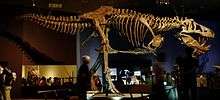
On 16 August 1991, then-high school principal Robert Gebhardt joined Royal Saskatchewan Museum palaeontologists on a prospecting expedition to the exposed bedrock along the Frenchman River Valley located in southwestern Saskatchewan, Canada to learn how fossils are found and identified in the field. Within a half a day, he discovered the base of a heavily worn tooth, and a vertebra from the tail, both suggesting that they belonged to a T. rex. In June 1994, RSM palaeontologists led by Tim Tokaryk (who gave Scotty her name) began excavating the T. rex. Locals say Scotty was named so after Tokaryk bought an expensive bottle of Scotch Whisky to celebrate the discovery. The 66 million year old skeleton was the first T. rex skeleton found in Saskatchewan and one of only 12 known in the world at the time. Scotty is one of the largest and most complete skeletons unearthed measuring an estimated 12 meters in length, with almost 70% of the skeleton found. A complete articulated cast of the skeleton was finally completed in 2012 and is now on display at its permanent home at the T.rex Discovery Centre located in Eastend, Saskatchewan, Canada near to the location of the discovery. This museum also contains the only known T. rex coprolite, or fossilized dung. Scotty is estimated to be the most massive T. rex specimen to ever be found, with a femur that weighs 195 pounds. Scotty's skull also sports a scar from the eye socket to the nostril, likely caused by another T. rex or large carnivore that gripped Scotty's skull in its jaws.[98]
"Tristan"
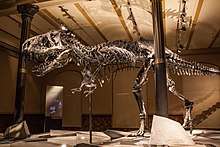
Commercial paleontologist Craig Pfister discovered and excavated the specimen from the lower Hell Creek Formation in Carter County, MT, in 2010.[99] It was later sold to Danish-born investment banker Niels Nielsen, who loaned the specimen for a minimum of three years to the Museum für Naturkunde in Berlin, Germany, for research and exhibition.[100] Nielsen and his friend Jens Jensen named the specimen Tristan-Otto (short: Tristan) for their sons.[101] The Naturkundemuseum Berlin lists it under specimen number MB.R.91216.[102] The matte-black fossilised skeleton was re-assembled from 300 separate parts, 170 of which are original, the rest reproductions. That would make Tristan one of the most complete Tyrannosaurus rex skeletons ever found (56.6% complete)
"Thomas"
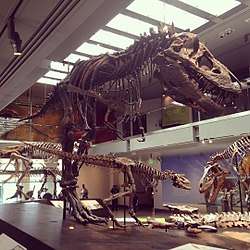
From 2003–2005, Thomas was excavated by NHMLA paleontologists in southeastern Montana. At 17 years old, 34 feet long and nearly 7,000 pounds, it is estimated to be a 70% complete specimen. Thomas is mounted in a "growth series" with the youngest known Tyrannosaurus rex fossil, a two-year old,11-foot long specimen, and a 13-year old juvenile specimen and 20 feet long.[103]
This fossil is one one of the geologically youngest T. rex specimens known, discovered very near the Cretaceous/Tertiary boundary.[104]
"Trix"
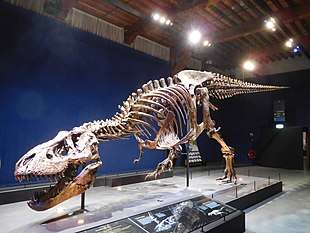
In 2013, a team of paleontologists from the Naturalis Biodiversity Center (Leiden, Netherlands) traveled to USA; Montana and discovered and unearthed a big and remarkably complete Tyrannosaurus rex specimen that lived 66 million years ago.[105] Black Hills institute collaborated with the team in the excavation. The bones were cleaned and assembled in a mount at Black Hills Institute's installations, with the help of both Chicago's Field Museum of Natural History and the Naturalis Leiden Museum. Chicago's Field museum sent digital models of their famous specimen, FMNH PR 2081 (Sue) to complete the cast and Naturalis museum replicated the bones using 3D printing technology. The specimen was named Trix after former Netherlands' Queen Beatrix, and is on public display since September 10, 2016 at the only room of the Naturalis museum open to public, due to the fact that the museum is undergoing restoration. Trix will stay there until June 2017, and then will travel on an international tour to finally find its new permanent home at the Naturalis museum once the museum's restoration ends at late 2018.[106]
According to Peter Larson, director of Black Hills Institute; Trix is the second most complete Tyrannosaurus found. Between 75% and 80% of its bone's volume has been recovered.[107][108]
Trix's age has been estimated by counting the growth lines in the bones. Two different methods were used for this; a xray microtomography, which can be done without damaging the bones, and a very small hole drilled in the fibula to allow comparison with the results of the x-ray based technique. This study was carried out in collaboration with a Belgian researcher from the Free University of Brussels, and attached to the Royal Belgian Institute for Natural History. The growth lines were numerous, and difficult to distinguish. These facts alongside the roughness and rugosity of the skull are indications that this individual had reached an old age for a T. rex; in this case at least thirty years, as opposed to Sue's 28 years old (Sue was the oldest Rex found before Trix's discovery), making Trix the oldest Tyrannosaurus known [109]
"Tufts-Love": UWBM 99000
In 2016 Greg Wilson, David DeMar, and a paleontology team from the Burke Museum of Natural History and Culture excavated the partial remains of a Tyrannosaurus rex from Montana. The partial skeleton was found by two Burke Museum volunteers, Jason Love and Luke Tufts, and was named the "Tufts-Love" T. rex.[110]
The Tufts-Love T. rex is currently undergoing preparation by Michael Holland and his team at the Burke Museum. The skeleton is estimated to be 30% complete, but it includes a near complete and mostly articulated skull. Michael Holland describes the skull as minimally distorted and in an "exquisite" state of preservation.[111]
See also
Notes
- ↑ Radiometric dating had not yet been developed at the time of this quote, so absolute ages of geologic events could only be estimated. Tyrannosaurus is now known to have lived approximately 66 million years ago.
References
- 1 2 Osborn, H.F. (1905). "Tyrannosaurus and other Cretaceous carnivorous dinosaurs". Bulletin of the American Museum of Natural History. 21 (3): 259–265. doi:10.1111/j.1468-5965.2007.00735_17.x.
- ↑ Osborn, H.F. 1906. Tyrannosaurus, Upper Cretaceous carnivorous dinosaur (second communication). 22: 281–296.
- ↑ Quinlan, Elizibeth D.; Derstler, Kraig; Miller, Mercedes M. (2007). "Anatomy and function of digit III of the Tyrannosaurus rex manus". Geological Society of America Annual Meeting — Abstracts with Programs: 77.
- ↑ Osborn, H. F. (1917). "Skeletal adaptations of Ornitholestes, Struthiomimus, Tyrannosaurus". Bulletin of the American Museum of Natural History. New York City: American Museum of Natural History. 35 (43): 733–771. hdl:2246/1334.
- ↑ http://www.plosone.org/article/info%3Adoi%2F10.1371%2Fjournal.pone.0026037
- 1 2 Brown, B. (1915). "Tyrannosaurus, a Cretaceous carnivorous dinosaur, the largest flesh-eater that ever lived". Scientific American. 63 (15): 322–323.
- ↑ Norell, M. A.; Gaffney, E. S.; Dingus, L. (1995). Discovering Dinosaurs in the American Museum of Natural History. New York: Knopf. p. 117. ISBN 0-679-43386-4.
- ↑ Kenneth Carpenter & Philip J. Currie (1990). "Variation in Tyrannosaurus rex". Dinosaur Systematics. Cambridge University Press. p. 143. ISBN 0-521-43810-1.
- ↑ Osborn, H.F. (1913). "Tyrannosaurus: restoration and model of the skeleton". Bulletin of the American Museum of Natural History. 32: 91–92.
- ↑ name=Tyrannosaurus Rex, the Tyrant King. (2018). Google Books. Retrieved 28 March 2018, from https://books.google.ca/books?id=5WH9RnfKco4C&pg=PA59&lpg=PA59&dq=when+was+AMNH+5866+sold&source=bl&ots=085LT-0JLv&sig=3WDSn04B0lZOjgIduNI4VCoEb6M&hl=en&sa=X&ved=0ahUKEwjN3eWD4Y_aAhXl7YMKHWTEDzMQ6AEIODAB#v=onepage&q=when%20was%20AMNH%205866%20sold&f=false
- 1 2 3 Horner, J.R. & Lessem, D. 1993. The Complete T. rex New York: Simon & Schuster. 238pp.
- ↑ "STAN T. rex" Black Hills Institute for Geological Research, Inc. 2004. Retrieved 16 July 2005.
- ↑ "''www.uleth.ca''". Uleth.ca.
- ↑ They Tyrant king (Carpenter, Larson, Horner, pp 17
- ↑ ''Tyrannosaurus rex, the tyrant king'' by Peter Larson and Kenneth Carpenter, side 51.''. Books.google.se. Retrieved 2012-10-29.
- ↑ Wolff, ED; Salisbury, SW; Horner, JR; Varricchio, DJ (2009). "Common Avian Infection Plagued the Tyrant Dinosaurs". PLoS ONE. 4: e7288. Bibcode:2009PLoSO...4.7288W. doi:10.1371/journal.pone.0007288. PMC 2748709. PMID 19789646.
- ↑ www.dinosauria.com.
- ↑ "Naturhistoriskt Museum, university in Oslo homepage (in Norwegian)" (in Norwegian). Nhm.uio.no. Retrieved 2012-10-29.
- ↑ Schweitzer, Mary H.; Wittmeyer, Jennifer L.; Horner, John R. (2008). "One pretty amazing T. rex.". In Larson, Peter; Carpenter, Kenneth. Tyrannosaurus rex the Tyrant King. pp. 92–100.
- ↑ Erickson, Gregory M.; Currie, Philip J.; Inouye, Brian D.; Winn, Alice A. (2006). "Tyrannosaur Life Tables: An Example of Nonavian Dinosaur Population Biology". Science. 313 (5784): 213–217. Bibcode:2006Sci...313..213E. doi:10.1126/science.1125721. PMID 16840697.
- ↑ Larson, Peter H. (2008). "Variation and Sexual Dimorphism in Tyrannosaurus rex.". In Larson, Peter; Carpenter, Kenneth. Tyrannosaurus rex the Tyrant King. pp. 103–128.
- ↑ Edgar, Blake. "''Discovery Channel's'' homepage". Dsc.discovery.com. Archived from the original on 10 October 2012. Retrieved 29 October 2012.
- ↑ "''www.unearthingtrex.com''". Unearthingtrex.com. 26 June 2002. Retrieved 2012-10-29.
- ↑ "Naturhistoriska riksmuseet's homepage". Nrm.se. Archived from the original on 17 June 2012. Retrieved 29 October 2012.
- ↑ "''archosaurmusings.wordpress.com''". Archosaurmusings.wordpress.com. Retrieved 2012-10-29.
- ↑ "''www.americantowns.com''". Americantowns.com. Retrieved 2012-10-29.
- ↑ "''staff.science.nus.edu.sg''". Staff.science.nus.edu.sg. 31 January 1996. Archived from the original on 21 January 2016. Retrieved 29 October 2012.
- 1 2 3 4 5 Hutchinson, J. R.; Bates, K. T.; Molnar, J.; Allen, V.; Makovicky, P. J. (2011). "A Computational Analysis of Limb and Body Dimensions in Tyrannosaurus rex with Implications for Locomotion, Ontogeny, and Growth". PLoS ONE. 6 (10): e26037. Bibcode:2011PLoSO...626037H. doi:10.1371/journal.pone.0026037.
- ↑ "T. rex arrives at National Museum of Scotland". Retrieved 2011-07-29.
- 1 2 3 Schontzler, Gail. "Montana T. rex Heading to Smithsonian." Bozeman Daily Chronicle. 28 June 2013. Accessed 2013-06-28.
- ↑ du Lac, J. Freedom "Tyrannosaurus rex Gets Long-Term Lease at Smithsonian's Natural History Museum." Washington Post. 27 June 2013. Accessed 2013-06-28.
- ↑ "The Story of a Dinosaur Named Sue" by Neal Larson. Black Hills Institute of Geological Research, Inc. 19 May 2000. Retrieved 16 July 2006.
- ↑ "Sue at the Field Museum" Field Museum of Natural History. 9 September 2005. Retrieved 16 July 2006.
- ↑ "Dino-Sue". Walt Disney World official website. The Walt Disney Company. Retrieved 2016-08-23.
- ↑ The Field Museum. "Unearthing the Secrets of Sue: Educator Guide" (PDF) (Second ed.). pp. 3, 52. Retrieved 9 July 2016.
- ↑ Brochu, C.R. (2003). "Osteology of Tyrannosaurus rex: insights from a nearly complete skeleton and high-resolution computed tomographic analysis of the skull". Memoirs of the Society of Vertebrate Paleontology. 7: 1–138. doi:10.2307/3889334. JSTOR 3889334.
- ↑ Hartman, Scott (July 7, 2013). "Mass estimates: North vs South redux". Scott Hartman's Skeletal Drawing.com. Retrieved August 24, 2013.
- ↑ "Sue Fact Sheet" (PDF). Sue at the Field Museum. Field Museum of Natural History.
- ↑ Erickson, Gregory M.; Makovicky, Peter J.; Currie, Philip J.; Norell, Mark A.; Yerby, Scott A.; Brochu, Christopher A. (2004). "Gigantism and comparative life-history parameters of tyrannosaurid dinosaurs". Nature. 430 (7001): 772–775. Bibcode:2004Natur.430..772E. doi:10.1038/nature02699. PMID 15306807.
- ↑ http://archive.fieldmuseum.org/sue/#sues-vital-stats
- ↑ https://www.fieldmuseum.org/educators/resources/sue-educator-guide
- ↑ http://www.nwitimes.com/entertainment/arts-and-theatre/sue-s-a-monster-specimen-marketing-force/article_1da472fe-f8c5-5ad1-b0b4-4ba988da8953.html
- ↑ Many sources says that "Stan" is the second most complete specimen, except for "Sue" (FMNH PR 2081). 65% of his total skeleton was found "Archived copy". Archived from the original on 1 October 2011. Retrieved 1 October 2011. "Archived copy". Archived from the original on 18 September 2010. Retrieved 18 September 2010. .
- ↑ The Manchester Museum's homepage: "Stan the Tyrannosaurus rex".
- ↑ Sign On San Diego"New Mexico museum has funds for half a T. rex", 26 February 2006.
- ↑ Get Cynical: "T-Rex Replica Skeletons for Sale", 21 July 2008.
- ↑ Stan 'n Sue comparison. (2017). DeviantArt. Retrieved 13 June 2017, from http://scotthartman.deviantart.com/art/Stan-n-Sue-comparison-360918612
- ↑ Comment on Stan 'n Sue comparison by ScottHartman – DeviantArt. (2017). DeviantArt. Retrieved 13 June 2017, from http://comments.deviantart.com/1/360918612/3885427583
- ↑ The Children's Museum of Indianapolis's homepage: General information Archived 20 November 2010 at the Wayback Machine..
- ↑ Santa Fe New Mexican: "Rare T. rex footprints in New Mexico help round out picture of prehistoric giant", 12 July 2009.
- ↑ "On Google campus, a dinosaur is forever in battle with hordes of flamingos". BoingBoing. 2014-07-25. Retrieved 2016-08-23.
- ↑ http://www.bhigr.com/
- ↑ Bates K.T, Hodgetts D, Manning P. L & Sellers W. I, "Estimating Mass Properties of Dinosaurs Using Laser Imaging and 3D Computer Modelling", Public Library of Science Journals, 19 February 2009.
- ↑ photonics: "T.rex or T. anorex?", 20 February 2009.
- ↑ New Mexico Museum of Natural History and Science homepage: "T. REX ATTACK!" Archived 5 June 2010 at the Wayback Machine..
- ↑ Horner J.R, Wolff E.D.S et.al, "Common Avian Infection Plagued Tyrant Dinosaurs", Public Library of Science Journals.
- ↑ "''article-niche.com''". Article-niche.com. 4 March 2009. Retrieved 2012-10-29.
- ↑ Miller, Jared (7 May 2004). "''www.greatfallstribune.com/news''". Greatfallstribune.com. Retrieved 2012-10-29.
- ↑ Metacarpal III has also been found in "Wyrex" ( see Tyrannosaurus rex, the tyrant king by Peter Larson and Kenneth Carpenter, page 55).
- ↑ However, different sources quote different degrees of completeness. For example, Tyrannosaurus rex, the tyrant king (Carpenter and Larson), side 51, suggest that about 40% of Peck's Rex bones are known, while other sources claim 80% or more (see http://article-niche.com/launch/Digging-For-Dinosaurs.htm). Another source argues it is the second best preserved Tyrannosaurus skeleton (see http://www.ckpreparations.com/currentprojects Archived 23 July 2012 at the Wayback Machine.), and Black Hills Institute says it's complete to about 30% (see their Tyrannosaurus rex specimens list at http://www.bhigr.com/pages/info/rex_chart.htm).
- ↑ "Parasite may have felled a mighty T. rex | Paleontology". Science News. Retrieved 2012-10-29.
- ↑ "''dml.cmnh.org''". Dml.cmnh.org. 13 June 2005. Retrieved 2012-10-29.
- ↑ www.visitmt.com.
- ↑ Potter, Chris. "''www.pittsburghcitypaper.ws''". Pittsburghcitypaper.ws. Retrieved 2012-10-29.
- ↑ "''www.post-gazette.com''". Post-gazette.com. 12 June 2008. Retrieved 2012-10-29.
- ↑ Carnegie Museum of Natural History's homepage. Archived 13 June 2010 at the Wayback Machine.
- ↑ Carnegie Museum of Natural History's homepage. Archived 30 July 2010 at the Wayback Machine.
- ↑ "Fort Peck's "Giftshop"". Fortpeckpaleo.com. Retrieved 2012-10-29.
- ↑ https://www.army.mil/article/146322/What_s_the_Army_doing_with_dinosaurs__Redux/
- ↑ "Unearthing T.Rex". Black Hills Institute. Retrieved 5 April 2011.
- 1 2 Crosslin, Rick; Mary Fortney; Dinosphere Exhibit Development Team (2004). "Resource Materials: Bucky-Tyrannosaurus rex". Dinosphere: A 3–5 Unit of Study.
- ↑ "The Origin of Birds". The Macro Library. University of California. Retrieved 5 April 2011.
- ↑ Larson, Peter. The First Recognized Furcula For Tyrannosaurus Rex. Black Hills Institute of Geological Research.
- 1 2 Larson; Peter Larson; Kenneth Carpenter (2008). "One Hundred Years of Tyrannosaurus Rex: The Skeletons". Tyrannosaurus Rex, the Tyrant King: 43–44.
- ↑ "Tyrannosaurus rex Bucky Sub-adult Skeleton-Fossil Replica". Black Hills Institute of Geological Research. Retrieved 26 February 2011.
- ↑ Crosslin, Rick; Mary Fortney; Dinosphere Exhibit Development Team (2004). "Tyrannosaurus rex Attack Scene-What will be the outcome?". Dinosphere: A 3–5 Unit of Study: 88.
- ↑ Larson, Neal L.; Peter Larson; Kenneth Carpenter (2008). "One Hundred Years of Tyrannosaurus Rex: The Skeletons". Tyrannosaurus Rex, the Tyrant King: 43–44.
- ↑ "Bucky's Discovery". The Children's Museum of Indianapolis. Archived from the original on 15 April 2011. Retrieved 26 February 2011.
- ↑ "NIU teams up with Burpee Museum to bring world's top dinosaur hunters to Rockford". Northern Illinois University. 7 September 2007. Archived from the original on 5 August 2012. Retrieved 9 September 2007.
- ↑ News Release: NIU teams up with Burpee Museum to bring world's top dinosaur hunters to Rockford Archived 5 August 2012 at Archive.is
- ↑ Larson (2005). "A case for Nanotyrannus." In "The origin, systematics, and paleobiology of Tyrannosauridae", a symposium hosted jointly by Burpee Museum of Natural History and Northern Illinois University.
- ↑ Currie, Henderson, Horner and Williams (2005). "On tyrannosaur teeth, tooth positions and the taxonomic status of Nanotyrannus lancensis." In "The origin, systematics, and paleobiology of Tyrannosauridae", a symposium hosted jointly by Burpee Museum of Natural History and Northern Illinois University.
- ↑ Henderson (2005). "Nano No More: The death of the pygmy tyrant." In "The origin, systematics, and paleobiology of Tyrannosauridae", a symposium hosted jointly by Burpee Museum of Natural History and Northern Illinois University.
- ↑ Larson, P. L. 2013. The case for Nanotyrannus in J. M. Parrish, R. A. Molnar, P. J. Currie., and E. B. Koppelhus (eds.) Tyrannosaurid Paleobiology, University of Indiana Press, Bloomington and Indianapolis, pp. 15–53.
- ↑ Yun, C (2015). "Evidence points out that "Nanotyrannus" is a juvenile Tyrannosaurus rex". PeerJ. 3: e1052. doi:10.7287/peerj.preprints.852v1.
- ↑ Larson, Peter L.; Carpenter, Kenneth (2008). Tyrannosaurus rex, the Tyrant King. Bloomington, Ind.: Indiana University Press. p. 39. ISBN 9780253350879.
- ↑ Larson, Peter L.; Carpenter, Kenneth (2008). Tyrannosaurus rex, the Tyrant King. Bloomington, Ind.: Indiana University Press. p. 40. ISBN 9780253350879.
- ↑ Schweitzer, M.H.; Wittmeyer, J.L.; Horner, J.R.; Toporski, J.B. (2005). "Soft Tissue Vessels and Cellular Preservation in Tyrannosaurus rex". Science. 307 (5717): 1952–1955. Bibcode:2005Sci...307.1952S. doi:10.1126/science.1108397. PMID 15790853.
- ↑ "Scientists recover T. rex soft tissue". Retrieved 2006-03-28.
- ↑ Fields, H. "Dinosaur Shocker". Smithsonian Magazine Online. Retrieved 2006-05-01.
- ↑ Fox, Maggie (30 July 2008). "Scientists question dinosaur soft tissue find". Reuters. Retrieved 2008-07-30.
- ↑ Beall, Abigail (March 15, 2016). "Could we soon CLONE a T-Rex?". Daily Mail. Retrieved June 15, 2016.
- ↑ "Carnegie Museum digs into controversial, but promising T-rex skull" by Byron Spice. Pittsburgh Post-Gazette. 12 May 2004. Retrieved 16 July 2006.
- ↑ "It's "Bone Voyage" for a famous fossil" by Dan Lagiovane. Carnegie Museum of Natural History [via Internet Archive]. 2 March 2006. Retrieved 30 December 2010.
- ↑ https://www.bonhams.com/auctions/17517/lot/23/
- ↑ https://www.fossilera.com/blog/new-arrivals-t-rex-nanotyrannus-teeth-from-south-dakota
- ↑ billingsgazette
- ↑ Roberts, David (30 June – 1 July 1994). "T-rex bones called find of giant significance". p. A7. Deseret News. Retrieved 17 August 2014.
- ↑ Cookson, Clive (25 September 2015). "How to buy a Tyrannosaurus Rex". Financial Times. Retrieved 1 January 2016.
- ↑ Gennies, Sidney (17 December 2015). "T-Rex Tristan: Entzauberung eines Mythos". Der Tagesspiegel. Retrieved 1 January 2016.
- ↑ Karberg, Sascha (13 July 2015). "Schädel eines T. Rex in Berlin eingetroffen". Der Tagesspiegel. Retrieved 1 January 2016.
- ↑ "tristan-otto". Tristan-Otto. Museum für Naturkunde. Retrieved 1 January 2016.
- ↑ "Dinosaur Hall". Natural History Museum of Los Angeles County. 2010-12-15. Retrieved 2018-06-04.
- ↑ "Collection Highlights". dinosaurs.nhm.org. Retrieved 2018-06-04.
- ↑ http://www.unit.nl/news/2016/trix-and-isabella-rozendaal
- ↑ http://www.dutchnews.nl/features/2016/09/trix-the-t-rex-makes-her-mark-on-leiden95266/
- ↑ http://www.thefossilforum.com/uploads/monthly_2016_09/10.thumb.jpg.592a065fd0a51cd2c23fa6d1a2063c29.jpg
- ↑ http://www.chicagotribune.com/entertainment/ct-ent-0824-trex-trix-ohare-dutch-20160823-story.html
- ↑ http://www.naturalis.nl/media/library/2016/06/Pressfile_T.rex_June_2016.pdf
- ↑ https://www.burkemuseum.org/blog/burke-museum-team-discovers-t-rex
- ↑ https://www.burkemuseum.org/blog/tyrannosaurus-rex-gigantic-beast